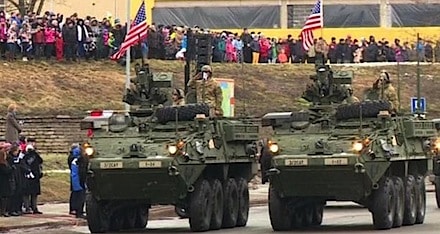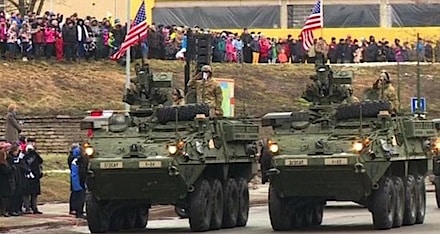
Around 200,000 US troops are stationed in 177 countries throughout the world. The forces use several hundred bases, more than 1,000 if the figure includes overseas warehouse and installations. The US may need more soon, with its presence and involvement in armed conflicts on the rise.
It was reported on August 7 that the Pentagon plans to conduct airstrikes on Islamic State (IS) in the Philippines. This move will be part of the effort to rout IS militants who occupied Marawi, a city in the south of the Philippines, in May, prompting President Rodrigo Duterte to declare martial law in the entire southern region of Mindanao and ask the US for help. In June, the Joint Special Operations Task Force Trident joined the battle.
Just three days before that (on August 4), it was reported by the Pentagon that a Special Operations Forces (SOF) team was deployed to Yemen to support the ongoing United Arab Emirates (UAE) operation against the Al Qaida in the Arabian Peninsula (AQAP) terror group. The amphibious assault ship Bataan with several hundred Marines aboard is also operating in the region. Close-air support missions in the current offensive against AQAP are not ruled out.
On August 7, the US was also reported to be sending dozens more Marines to Helmand Province in southwestern Afghanistan. Army Gen. John Nicholson as the US commander in that country has been lobbying for 3,000 to 5,000 troops in addition to the 8,400 US service members already on the ground.
In June, the US increased the size of its special operations advisory force embedded with the Syrian Democratic Forces as the group prepared its invasion of Raqqa, Syria. Around 1,000 US service members are believed to be operating there.
The SOF play a special role to implement the “here, there and everywhere” policy. In 2016, the US SOF teams conducted missions in 138 countries – roughly 70 percent of the nations on the planet. The Special Operations Command is tasked with carrying out 12 core missions. Last year, US SOF were deployed to 32 African nations, about 60 percent of the countries on the continent. Navy SEALs, Green Berets, and other special operators are now conducting nearly 100 missions across 20 African countries at any given time. They are deployed in Libya – the country, which has its future uncertain after the 2011 US-led NATO involvement.
The US war footprint grows in the Middle East with no endgame in sight. In his remarks at the Conservative Political Action Conference (CPAC) Donald Trump said that the last 15 years of US military action in the Middle East had been an almost incomprehensible waste of money – six trillion dollars – and that after all that US war and meddling the region was actually in a worse shape than before the operations were launched. So, the policy was wrong, the president understands that and…keeps on doing the very same thing on a larger scale!
The presence in Europe is on the rise. Troops are being deployed to countries they had no presence in before, such as Norway and Estonia. It’s not forces only but also the costly logistics infrastructure. The military wants more large-scale exercises in Europe to further boost the presence and expand infrastructure there. During his recent foreign trip, Vice President Mike Pence said the US Air Force would deploy twice as many jets during the Russian exercise Zapad-2017 to be held in September.
The US military is calling for even greater presence in Europe. Air Force Brigadier General John Healy, the director of US exercises in Europe, says he wants one comprehensive training maneuver would be crucial in testing NATO’s preparedness for a global showdown with Russia. As he put it, “What we’re eventually going toward is a globally integrated exercise program so that we (are) … all working off the same sheet of music in one combined global exercise.” The military leader believes the exercise should encompass all domains of war – land, sea, air, space and cyber and involve all nine US combatant commands.
Under President Trump, drone strikes worldwide grew 432 percent as of mid-March. Civilian death toll is significant in Iraq and Syria as a result of US bombardment.
A war with Iran appears to be imminent. An attack against North Korea is on the cards. There is a plan to spend $8 billion on bulking up the US presence in the Asia-Pacific region over the next five years by upgrading military infrastructure, conducting additional exercises and deploying more forces and ships.
All these facts make one recall the events that took place just a few months ago. President Trump said he would avoid interventions in foreign conflicts. Instead of investing in wars, he would spend money to build up America’s aging roads, bridges and airports. But there was a loophole. He promised to stay away from all other conflicts except Islamic State militancy.
Everybody thought he meant only airstrikes in the Middle East. Now it looks like the president meant the other regions as well. The Islamic State is present in Afghanistan and Africa. The IS terrorists have recently staged a terrorist act in Iran. They take responsibility for terrorist attacks in Europe. Jihadists operate in Russia and Central Asia. Their presence is menacing in the Asia-Pacific region. They are almost everywhere to serve as a pretext for US invasions or war preparations in almost any corner of the globe.
The United States in actually one way or another involved in all hot spots on the world map. No doubt, it will expand the involvement in the Philippines, Somalia, Afghanistan, Yemen, and boost the naval and air force presence in the Asia Pacific to oppose China – a move not related to the IS by any stretch of imagination as well as the beefing up of forces in Europe.
So, it’s Europe, Asia-Pacific, the Middle East and Africa! It feels like the United States is always at war or preparing for a war somewhere. Yemen on August 4, the Philippines on August 7, perhaps some other place a few days later, you never know what to expect. It’s like the “perpetual war for perpetual peace“ described by Charles Beard.
No matter how high the military expenditure is, the US military is doomed to be stretched thin until the policy is not changed. One cannot square the circle or embrace the boundless. The nation has a huge national debt. If the enemy is the Islamic State than the intelligence and military efforts should be concentrated on the mission to strike the group, not a number of tall orders to be accomplished by and large at the very same time.
With one mission accomplished, the US could review the priorities. The thing is – it will never be accomplished because the IS is not only militants, but rather the ideology that drives them. This evil cannot be defeated by the people in uniform alone. But that’s a different story to talk about in another article. Anyway, stretching the resources thin is not an effective policy. The United States will be following two hares catching neither instead of setting the priorities straight and focusing on what is the primary mission.
Reprinted with permission from the Strategic Culture Foundation.

